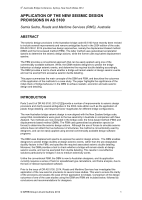Bridges

Application of The New Seismic Design Provisions in AS 5100
- Publication no: ABC-DES704-14
- Published: 22 October 2014
- PDF (free) Download
The seismic design provisions in the Australian bridge code AS 5100 have recently been revised to include several improvements and remove ambiguities found in the 2004 edition of the code. DR AS 5100.2: 2014 provides two design approaches, namely the displacement-based method (DBM) and the force based method (FBM). The latter method uses generalised acceleration spectra to determine the seismic design actions, while the former uses equivalent displacement spectra. The FBM provides a conventional approach that can be easily applied using one of the commercially available software products. The DBM enables designers to predict the bridge behaviour at design seismic events, and determine the required ductile detailing accordingly. The DBM provides a tool to check whether a bridge will remain elastic at design seismic events and can be exempt from excessive seismic ductile detailing. This paper summarises the main concepts of the DBM and FBM, and describes the outcomes of the application of the methods to a case study. The paper highlights the significance of the initial check of bridge behaviour in the DBM to achieve realistic, economic and safe seismic design and detailing.
Related publications
ABC2022-110-22
Latest Bridges News
